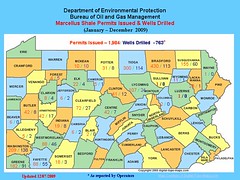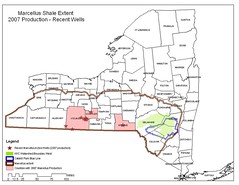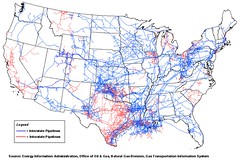This article, by Sue Smith-Heavenrich, reprinted from Tompkins Weekly on "Notes from the Museum" (of the Earth)'s blog, offers a clear explanation of the geology of the Marcellus shale and the role of hydrofracking in extracting gas from that fine clay layer.
Pick up a chunk of Marcellus shale and you immediately understand why energy companies are interested in it: it’s dark, like coal, and leaves a greasy smear on your hand. Like all sedimentary rock, the Marcellus shale was created by compressing layers of mud together for a long, long time. But unlike the shale you turn up in your garden, Marcellus doesn’t contain fossilized crinoid stems or brachiopods.
Rob Ross, associate director of outreach for the Paleontological Research Institute and the Museum of the Earth, says that to understand Marcellus, you need to understand where our part of the world was about 380 million years ago. Back then all the continents were smooshed together along the equator, and seawater covered our part of New York. It was a dynamic place, Ross says, thriving with ancient life and suffering the occasional underwater landslide.
When organisms died, they fell to the sea bottom and were covered with sediment. It was just like the mud in Cayuga Lake — a mix of clay and silt but low in oxygen. Over time more sediment collected, burying the Marcellus deeper. The organic matter, trapped in the shale and subjected to increasing pressure and heat, provided optimum conditions for the formation of natural gas, Ross explains. (You can read more at www.museumoftheearth.org.)
If you could slice through the earth, you’d notice that the rocks under New York are layered like a tall stack of pancakes — all 11,000 feet of them: sandstones, limestones and shales. And Marcellus shale is but one of the gas-bearing layers. Oriskany sandstone, located just below Marcellus, and Trenton- Black River, another four to five thousand feet down, also produce natural gas in this area.
Unlike sandstone, Marcellus shale is composed of fine-grained clay particles so tightly packed that there are very tiny spaces, or pores, between the particles. And those very tiny spaces are where the natural gas is trapped. Not only that, the pores are not connected to each other, so gas can’t travel from one pore to the next. The only way to extract gas from a stone with such low porosity and low permeability is to break it apart using a process called hydraulic fracturing.
Hydraulic fracturing seems like a modern invention, but it’s been used for thousands of years, says Tony Ingraffea. Ingraffea, a civil engineering professor at Cornell who studies fractures and spent a decade working with Schlumberger on the science of fracking. Ingraffea believes the Romans introduced water into cracks to aid in breaking rock. One way to frack with just water is to pour water into cracks in the rock and let it freeze, Ingraffea explains.
A rock is strong when you push on it, Ingraffea says. That’s compression. But a rock is weak when you pull on it, or put tension on it. Engineers use water pressure to put tension on rock and take advantage of the weakness of the rock when it’s under tension.
Initially hydro-fracking of oil and gas wells was used to open existing cracks. The process was called “stimulating” the well, and it increased the permeability of the rock mass by enarlging existing fractures. “As long as the pores in the rock are interconnected, you can get oil to flow,” Ingraffea says. But in shale the pores are not interconnected, which makes the rock impermeable to water. “This is good from a fracking point of view,” Ingraffea says,” because the water will create fractures without going into the rock.”
Because the layer of Marcellus shale is only 50 to 250 feet thick companies developed horizontal drilling to expose more shale to hydro-fracking. Once the horizontal casing is in place, the driller uses a shaped charge to perforate the case.
“There’s no explosion,” Ingraffea explains. A charge is fired electronically and releases a high temperature liquid that melts through the casing. The charge burns through the rock a few feet, leaving small holes. Each of those holes becomes a starting place for a fracture, when the water and sand are pumped into the well under high pressure.
What people don’t understand is the extent of drilling required to extract the gas trapped in the rock, Ingraffea says. Hydro-fracking is just a small part of what Ingraffea describes as a “highly engineered and industrial operation.”
“Gas wells won’t be dotting the area,” Ingraffea says. “They will be covering the area. For efficient extraction of the gas we will eventually end up with multiple wells every 80 acres,” he suggests, citing new research from Terry Engelder at Pennsylvania State University. “That will be a huge industrial impact in our area.”
This industrialization will put added demand on an already strained infrastructure, Ingraffea says, explaining that the region’s roads and bridges are not suited for the heavy traffic anticipated with development of the Marcellus. The increased drilling activity and related activities not only raise the risk for accidents, such as valve failures, leaks, improper cemented casings, but also increase the risk of spills with the transportation of wastewater and brine. Extracting gas brings a complex system of inter-related activities and events, Ingraffea points out.
“The question we should be asking is why now?” Ingraffea says. “Why is there a rush to develop the gas fields? Why don’t we have a national energy strategy that promotes energy development."
LINKDEMAND ACCOUNTABILITY!



















No comments:
Post a Comment